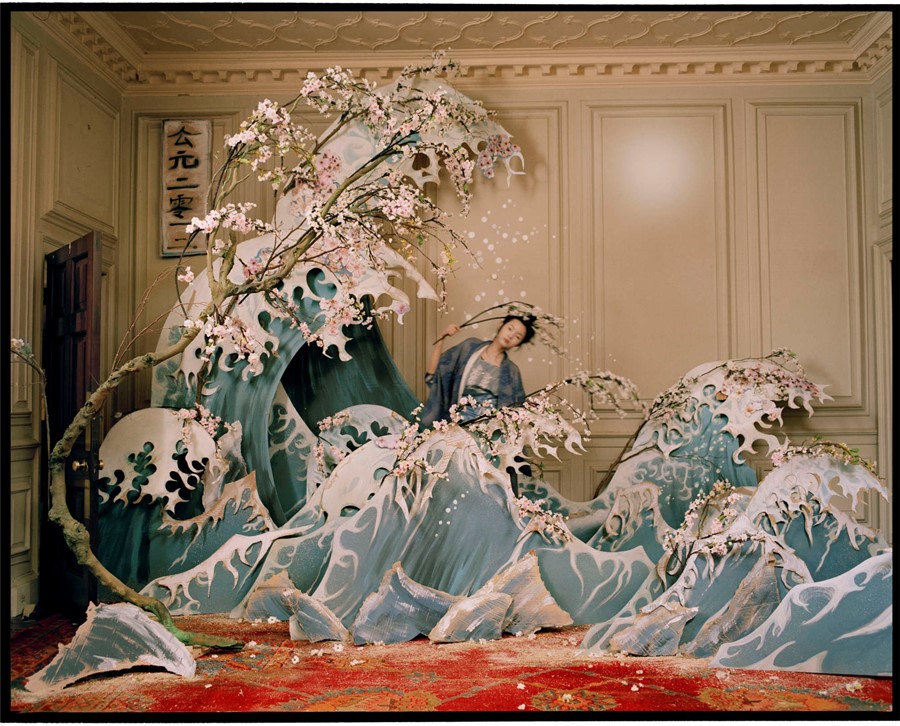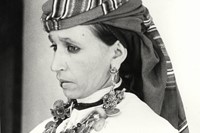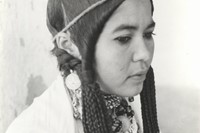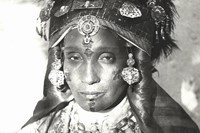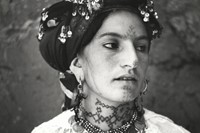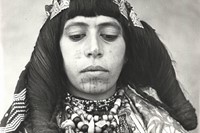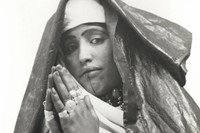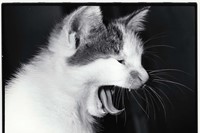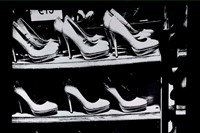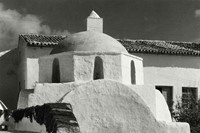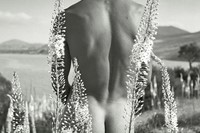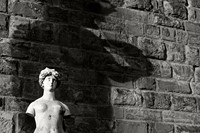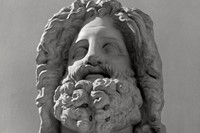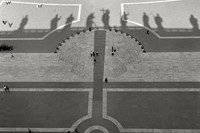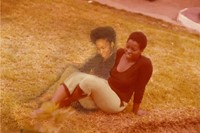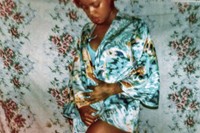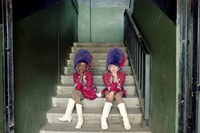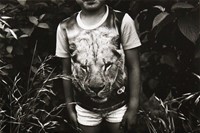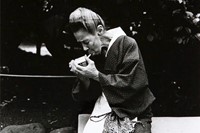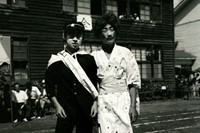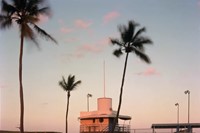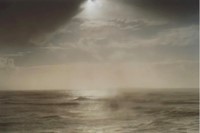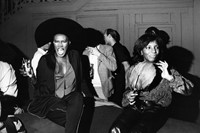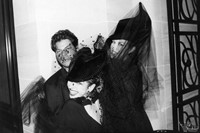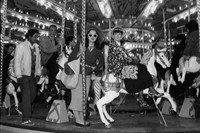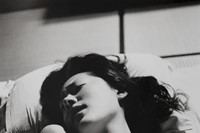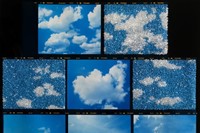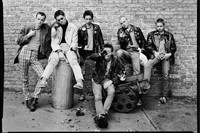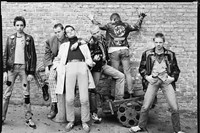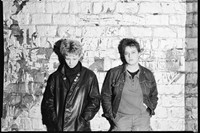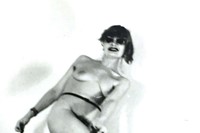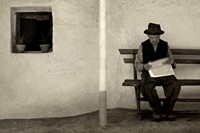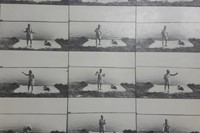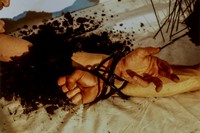We round up the best booths and exhibitions from this year’s festival, from Herbert List’s sun-soaked shots of the Mediterranean to Hungary’s most exciting new image-makers
After its suspension last year due to lockdown, Paris Photo (on view through this weekend until November 14) has returned to showcase every genre and era of photographic practice imaginable, from industry players all over the world. In the behemoth that is the Grand Palais Ephémère, booths unfurl from Avenue La Motte-Piquet to the Champs de Mars, ending with a dramatic postcard-style view of the Eiffel Tower. From amidst the mêlée, we have selected ten highlights that splendidly showcase the breadth of work on display.
Jean Besancenot at Galerie 127
Vintage prints by Jean Besancenot pack in the embellished garments and ornate bijoux worn by Jewish and Berber communities in 1930s Morocco, then quite unaffected by Westernisation. The subjects’ solemn expressions stand in contrast to the elaborate accessorizing. There are patterned fabrics, wrists stacked with bangles, long descending necklaces, pendulous earrings, and headpieces festooned with coin-like clusters. Besancenot took multiple trips throughout the decade, and his portfolio of portraits had an ethnographic bent: he filmed, drew and took extensive notes as well as frontally documenting ceremonial dress. He captured a stunning aesthetic as well as a regional index.
Michael Hoppen Gallery
London’s Michael Hoppen Gallery returns to the festival with a wide variety of work this year – some old, some new, and some never-before-seen. The spotlight mostly shines on acclaimed Japanese image-makers, with rare and beautiful prints on view from Daidō Moriyama, Araki, Akira Sato and Eikoh Hosoe. It’s an extensive selection, but the umbrella focus of it all is joy: “Paris Photo is a great opportunity for us to present photographs which we feel will enliven and entertain,” says a Michael Hoppen spokesperson, “but also to inform and advance the tradition of this fascinating medium forward.”
Herbert List at Galerie Karsten Greve
“La photographie est profondément habitée par la magie,” Herbert List once stated – photography is deeply animated through magic. The German-born photographer led a peripatetic life, rubbing shoulders with fashion photographer George Hoyningen-Huene and multi-hyphenate writer/artist/designer Jean Cocteau. In the sultry, sun-soaked settings of Greece, Italy, and other destinations of the Mediterranean basin, List returned regularly to the luminous region between 1930-1960. He foregrounded weathered statues, sun-baked stone churches, and lithe nude silhouettes. Boys, seen from a bird’s eye view, sun themselves all in row in Portofino; shirtless port workers expertly carry baskets on their heads in Andalusia. These are just some of scenes featuring the region’s beauty, which also extends to laurel leaves and lace curtains, gleaming glassware and craggy rocks.
Phumzile Khanyile, Lebohang Kganye, Alice Mann and Dimakatso Mathopa at AFRONOVA
AFRONOVA – a trailblazing gallery based in Johannesberg – is platforming four young South African women in its booth this year. This includes Phumzile Khanyile, a photographer known for her puckish, taboo-busting self-portraits; Lebohang Kganye, a visual artist interrogating the pervasive effects of tradition, history and memory; and Dimakatso Mathopa, a printmaker critiquing the white colonial gaze and stereotypical representations of Black women. Alice Mann, who won the 2018 Taylor Wessing Prize for her much-loved series Drummies, will also be featured.
Issei Suda at IBASHO Gallery
Japanese photographer Issei Suda (an AnOther favourite) began his career in 1967, working for an underground theatre troupe preoccupied by themes of fantasy within the day-to-day. Suda eventually embarked on his own to snap village festivals as well as urban dwellers – all while hinting at the inherent nature of quotidian performance. (“I can observe things objectively without getting deeply involved. This can be quite fun because I can construct my own drama in my mind,” he mused.) His most famous 1970s series, Fushi Kaden, highlights small but notable instances of telling body language, couched within ordinary scenes. In a street photograph of three girls advancing in kimonos, their eyes each scan different directions, self-conscious of the gazes that could land on them on all sides; another features two uniformed young men in jaunty caps and neckerchiefs, leaning casually but self-awarely against a wooden rail as they look out towards opposite horizons.
Huxley Parlour
What does it mean to leave a mark? This age-old question is the anchoring theme of Huxley Parlor’s offering at this year’s fair, which showcases an array of searching works by both established and emerging names like Joel Meyerowitz, Gregory Halpern, Jocelyn Lee, and Jem Southam. The selection upacks the ways artists have responded to “the fundamental philosophies of photography”, through imagery which maps journeys taken, lives lived, immutable landscapes, and personal identities.
Bill Cunningham at Bruce Silverstein
Bill Cunningham roamed the streets of his beloved New York – as well as other fashion-forward capitals – for over half a century. This particular 1970s-1980s sliver of Cunningham’s vast archive includes recognisable faces (Anna Piaggi alongside a ponytailed Karl Lagerfeld; Jerry Hall doing a high kick out from under her ruffled dress) as well as anonymous silhouettes with equal gravitational pull. Indeed, Cunningham celebrated the urban extravaganza, his kudos conveyed via his camera. He began publishing photographs in 1967, and spent the bulk of his career producing the columns “Evening Hours” and “On the Street” for the New York Times. (His first-wave career as a milliner is evident through his attraction to beautiful hats and veils: just look at the puffs of tulle cascading from the heads of two smiling, black-clad party-goers.) There are also women in animal-print coats, two side-by-side backless dresses that highlight the gorgeousness of shoulders, and even reverent attention paid to the simple beauty of stockinged calves and plain low-heeled pumps.
Gaze on Intimacy, In Camera Gallery
In reaction to today’s selfie culture, and modern customs of public performance online, In Camera Gallery presents a selection that tenderly explores the concept of photographic intimacy. Providing an insight into the special relationship between model and image-maker, the selection features a diverse range of works by the likes of Alexandra Catiere, Nobuyoshi Araki, Bertien van Manen, Laurence Sackman, Jane Evelyn Atwood, Andrea Torres Balaguer, Thomas Vandenberghe and Sissi Farassat.
Rudolf Schäfer at LOOCK
German-born photographer Rudolf Schäfer made his mark with the 1986 series Totengesichter (Faces of the Dead), tenderly cataloguing lifeless visages in a morgue in Berlin, an affecting meditation on mortality. However, the images on view here are full of life. They stem from his large-scale series Reproduktion, a study of East Germans amidst its bevy of socio-political changes. The most animated examples on view here are group portraits of rowdy, playful punks hunched against deteriorating walls: a nod to both youth culture and, as an adjacent text puts it, “the decay of East Berlin’s urban topography.” In their worn denim and personalized leather jackets, their communal goofing off together is strikingly endearing. There are also more formal but no less interesting group portraits: ensembles standing or seated before the camera as though in a school photo.
Hungarian Talent, Einspach Fine Art & Photography
Boundary-pushing image-makers from Hungary are being celebrated at the Einspach Fine Art & Photography booth. Featuring work from fashion photographer Zoltan Tombor and artist Orshi Drozdik (known mostly for her dark deconstructions of gender and pornography), the programme examines both emerging artists and avant-garde masters from the post-war period, in the hope to elevate and illuminate the Hungarian contemporary art scene.
